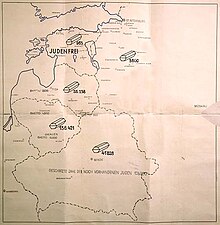Franz Walter Stahlecker
Walter Stahlecker | |
|---|---|
Franz Walter Stahlecker (10 October 1900 – 23 March 1942) was commander of the
Early life
Stahlecker was born into a wealthy family in
Early Nazi career
On 1 May 1932, Stahlecker joined the
On 29 April 1940, Stahlecker arrived in Oslo, Norway,[8] where he held various posts, most notably as commander of about 200 Einsatzgruppe members of the Security Police and SD. He was promoted to SS-Oberführer.[9] He was succeeded in this position in autumn 1940 by Heinrich Fehlis.[10]


Einsatzgruppe A
On 6 February 1941 Stahlecker was promoted to SS-
Considering that the population of the Baltic countries had suffered very heavily under the government of Bolshevism and Jewry while they were incorporated in the USSR, it was to be expected that after the liberation from that foreign government, they would render harmless most of the enemies left behind after the retreat of the Red Army. It was the duty of the Security Police to set in motion these self-cleansing movements, and to direct them into the correct channels in order to accomplish the purpose of the cleansing operations as quickly as possible. It was no less important, in view of the future, to establish the unshakeable and provable fact that the liberated populations themselves took the most severe measures against the Bolshevist and Jewish enemy quite on their own, so that the direction by German authorities could not be found out. In Lithuania this was achieved for the first time by Partisan activities in
Kowno. To our surprise it was not easy at first to set in motion an extensive pogrom against Jews. Klimatis, the leader of the partisan unit mentioned above, who was used for this purpose primarily, succeeded in starting a pogrom on the basis of advice given to him by a small advance detachment acting in Kowno, and in such a way that no German order or German instigation was noticed from the outside. During the first pogrom on the night of 25-26 [June], the Lithuanian partisans did away with more than 1,500 Jews, set fire to several Synagogues or destroyed them by other means, and burned down a Jewish dwelling district consisting of about 60 houses. During the following nights about 2,300 Jews were made harmless in a similar way.

By winter 1941, Stahlecker reported to the German government that Einsatzgruppe A had murdered some 249,420 Jews. He was made Commander of the Security Police and the SD (Befehlshaber der Sicherheitspolizei und des SD) of Reichskommissariat Ostland, which included the occupied territory of Estonia, Latvia, Lithuania and Belarus, at the end of November 1941.[13] Stahlecker was fatally wounded in action on 22 March 1942, by Soviet partisans near Krasnogvardeysk, Russia.[2] Heinz Jost then assumed command of Einsatzgruppe A and of the Security Police and SD.
See also
References
- OCLC 40486576.
- ^ a b c d e "Stahlecker, Franz Walter" (PDF). Shoah Resource Center. Yad Vashem. 2003. Retrieved 2009-04-05.
- ^ ISBN 0-8386-3418-4.
- ^ Longerich 2012, p. 404.
- ^ Saul Friedländer: Nazi Germany and the Jews: The Years of Persecution, 1933-1939, New York : HarperCollins, 1997, pp. 244–245
- ^ Longerich 2012, p. 441.
- ^ Gerwarth 2011, p. 158.
- ^ Gerwarth 2011, p. 175.
- ]
- ^ Longerich 2012, p. 492.
- ^ Office of the United States Chief of Counsel For Prosecution of Axis Criminality. . Vol. VII. Washington DC 1946. Translation of Document L-180, Action-group A: Nazi Conspiracy and Aggression (Red Series), NCA Volume VII; Exhibit L-180, pp. 978–995. Report page 983 – via Wikisource.
Cleansing and Securing the Area of Operations
{{citation}}: CS1 maint: location (link) - ISBN 978-0-06-019043-9
- ISBN 0-02-896090-4, p. 1404
Bibliography
- ISBN 978-0-7524-5974-5. Archived from the originalon 2020-10-23. Retrieved 2016-06-19.
- ISBN 978-0-300-11575-8.
- ISBN 978-0-19-959232-6.
